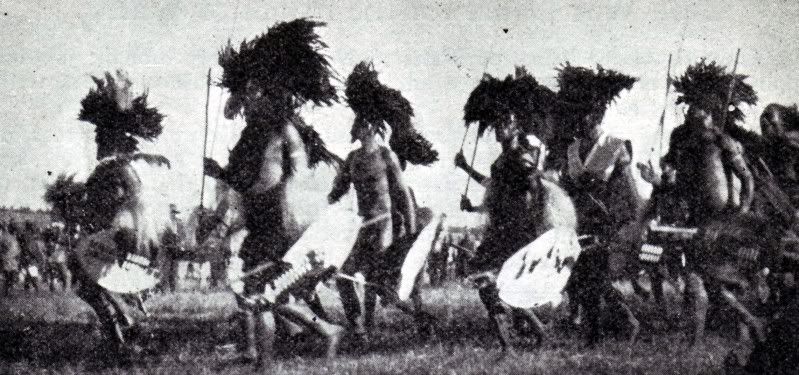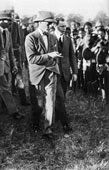 KwaZulu-Natal is a province of South Africa lying along the Indian Ocean, encompassing the traditional Zulu homelands. Early in the 19th century, the Zulu people consisted of only a few thousand people. By about 1820, ten years into the reign of their greatest leader and military genius Shaka Zulu, other tribes and lands had been conquered and brought into the Zulu nation, and Shaka could field an army of 100,000 warriors. Shaka was slain in 1828 by his brother Dingaan, just as the Zulus were coming into contact with European colonizers. Dingaan’s way of dealing with some of the Dutch invaders of his realm in 1837 was to invite them to a feast and massacre them.
KwaZulu-Natal is a province of South Africa lying along the Indian Ocean, encompassing the traditional Zulu homelands. Early in the 19th century, the Zulu people consisted of only a few thousand people. By about 1820, ten years into the reign of their greatest leader and military genius Shaka Zulu, other tribes and lands had been conquered and brought into the Zulu nation, and Shaka could field an army of 100,000 warriors. Shaka was slain in 1828 by his brother Dingaan, just as the Zulus were coming into contact with European colonizers. Dingaan’s way of dealing with some of the Dutch invaders of his realm in 1837 was to invite them to a feast and massacre them.
This launched a half-century of bloody conflicts between Zulu and Dutch, and later between Zulu and British. Although the Dutch and British always had the superior weapons, Zulu tactics and manpower often overwhelmed the Europeans (during one battle of the Anglo-Zulu War of 1879, the Zulus killed 1,000 British soldiers in one day, the single worst defeat of British troops by non-Europeans during the colonial era), and the outcome of the wars could never be taken for granted. The British finally subdued the Zulus in the 1880s, subdividing their land and appointing British rulers over each subdivision.
Zululand was incorporated into the Union of South Africa in 1910, which enjoyed limited independence as a British dominion (the nation won full independence in 1961 as the Republic of South Africa).
Which brings us to 1925 …
 Edward, Prince of Wales (1894-1972) (he who later became Edward VIII, king of England, and still later abdicated to marry American divorcee Wallis Simpson, becoming the Duke of Windsor), made a number of world tours in the 1920s, representing his father, George V. His travels in 1925 took him to South Africa, and in May, 1925, he visited Zululand as the guest of honor at one of the greatest gatherings of Zulu warriors ever held.
Edward, Prince of Wales (1894-1972) (he who later became Edward VIII, king of England, and still later abdicated to marry American divorcee Wallis Simpson, becoming the Duke of Windsor), made a number of world tours in the 1920s, representing his father, George V. His travels in 1925 took him to South Africa, and in May, 1925, he visited Zululand as the guest of honor at one of the greatest gatherings of Zulu warriors ever held.
Official events began at the tiny city of King Williamstown, where Edward listened to the “praise poems” of an imbongi. The scene was described by a journalist:
On the other side of the rose-strewn dais sat the omnipresent imbongi, the official shouter of praise poems; he wore a vermilion cape while his face displayed a deadly discomfort . . . then he drew himself to his full height and opened his large mouth; with his teeth gleaming in his black visage, he half-sang and half-spoke utterances of praise for His Highness. No doubt he asked that the heavens shower blessings on the Prince.
 That incident is well remembered in Zululand, because the imbongi was S.E.K. Mqhayi, sometimes called the “Shakespeare of Xhosa letters,” and because, unknown to his European guests, the “praise poem” was one part praise and ten parts condemnation:
That incident is well remembered in Zululand, because the imbongi was S.E.K. Mqhayi, sometimes called the “Shakespeare of Xhosa letters,” and because, unknown to his European guests, the “praise poem” was one part praise and ten parts condemnation:
Here comes the hero of Britain,
A descendant of the buffalo cow, Victoria,
That god-like woman in the land of humanity …
A man, the color of cow-dung.You sent us the truth, denied us the truth;
You sent us the life, deprived us of life;
You sent us the light, we sit in the dark,
Shivering, benighted in the bright noonday sun.
 The Prince, and as many whites from South Africa who could find places on the limited trains, then traveled to the inland city of Eshowe for an “indaba” (conference) … which brings us to the reason for this post on a Mormon history blog.
The Prince, and as many whites from South Africa who could find places on the limited trains, then traveled to the inland city of Eshowe for an “indaba” (conference) … which brings us to the reason for this post on a Mormon history blog.
Among the visitors to Eshowe were Leon Stinger Saunders (1902-1998) and Kenneth Claud Woodruff (1905-1983), both of Salt Lake City, and missionaries serving in South Africa.
Time Magazine described the events at Eshowe this way:
At Eshowe, Zululand, an indaba (conference) and war dance were held for the especial benefit of the Prince of Wales, whom the Zulus call “Lord of the Great Ones.”
On the outskirts of a parade ground were thousands of Zulu tribesmen. In the centre were 5,000 warriors, naked except for loincloths of leopard skin. On their left arms they carried shields, in their right hands their famous assagais (spears). On their heads were enormous spreading headdresses of black feathers. They began a kind of dance, worked themselves up through weird contortions to a “terrific frenzy” that was accompanied by blood-curdling yells and “dirgelike singing of the women.” The visit of the Prince had the effect of healing a long-standing breach between the Usutu (Royalists) and the Mandhlakazi (the ones of great strength), and together they came to offer tribute to the Great King’s son.
The Prince, in his address to them, referred to their great industry and warlike prowess, urged them to use their great attainments in work for peace and so win a right to responsible government.
Elder Woodruff recorded other details:
At Eshowe, a beautiful little town one hundred miles up the east coast of Africa from Durban and headquarters of the Great Zulu Nation, there was gathered together forty thousand natives picked from all the Zulu tribes, to pay a tribute to their future king, in the form of a demonstration war dance. This was the greatest war dance ever staged within the borders of Africa and it was a great opportunity, if not privilege, for the elders laboring in Natal to witness this savage event.
President Leon S. Saunders and Elder Kenneth C. Woodruff were fortunate in securing tickets on the special trains from Durban to Eshowe. These trains were equipped to provide accommodations for a limited number and we were among the lucky ones. At Eshowe we made our way to the scene of the War Dance, only to be amazed at the marvelous sight of multitudes of natives gathered together representing a huge horse shoe facing the canopy from which the Prince gave his commending speech to the Zulus. As the Prince came into view riding in his special motor car followed by his escort, the natives welcomed him with the impressive cry of “Bayette,” meaning “great king.”
The weird way in which they drawled the word out sounded as if the Prince of demons and all his force of imps had let out a cry of distress. After the king of the Zulus, King Solomon, had given his welcoming speech on behalf of the Zulu nation, he presented the Prince with a pair of magnificent elephant tusks mounted on a hard-wood base with a gold shield with the inscription engraved upon it, “To H.R.H. the Prince of Wales on behalf of the Zulu Nation.” In return for this beautiful gift the Prince presented each tribal chief with a silver studded cane. At dinner time the different cliques gathered for their usual meal of Kaffer beer and meat, which was heartily partaken of in preparation for the big event to follow.
After dinner the war dance started, and it was surely a sight that shall never depart from our memories. There was about one thousand specially picked up to take leading parts in the dance. Each tribe had its representative group form in long line and advance toward the Prince. The advance was slow and full of all kinds of maneuvers with an unceasing cry of weird shrieks and yells. At the rear of each group of warriors were the women and girls who spurred the men on to battle by singing and chanting to them.
Occasionally a number would step out in front of the advancing line and go through all sorts of funny motions. So even and uniform was the stamping of feet in the dance that it made the ground almost tremble. near the finish of the advancing a sham charge was effected, with assagias (spears) raised and shields in front of them as if to slaughter the whole crowd. although it was a sham, it gave some of the onlookers a fright that could not have been worse had the warriors carried out their threats.
After the dance this vast horde dispersed to their several kraals so that within an hour scarcely a native could be seen. It was a wonder to all where they so quickly and suddenly disappeared to.
The thing that was most noticeable to us was that out of that multitudinous gathering of Zulus we were unable to see one deformity, their bodies were perfect.
Missionaries had been present at the Cape at the extreme southern tip of South Africa since the 1850s – yet this may well have been the first Mormon exposure to the sight and culture of the native peoples of Africa.
Continue reading at the original source →



